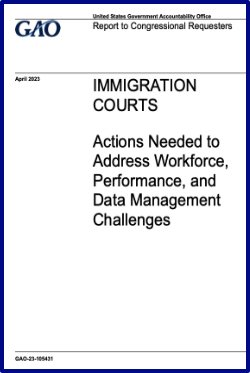By American Immigration Council
In recent months, leading politicians and policymakers have renewed calls for mass deportations of immigrants from the United States. While similar promises have been made in the past without coming to fruition—during the 2016 presidential campaign, for example, Donald Trump pledged to create a “deportation force” to round up undocumented immigrants —mass deportation now occupies a standing role in the rhetoric of leading immigration hawks. To cite just one example, former U.S. Immigration and Customs Enforcement (ICE) director Tom Homan has promised “a historic deportation operation” should a hawkish administration return to power.While some plans have envisioned a one-time, massive operation designed to round up, detain, and deport the undocumented population en masse, others have envisioned starting from a baseline of one million deportations per year.
Given that in the modern immigration enforcement era the United States has never deported more than half a million immigrants per year—and many of those have been migrants apprehended trying to enter the U.S., not just those already living here—any mass deportation proposal raises obvious questions: how, exactly, would the United States possibly carry out the largest law enforcement operation in world history? And at what cost?
Using data from the American Community Survey (ACS) along with publicly-available data about the current costs of immigration enforcement, this report aims to provide an estimation of what the fiscal and economic cost to the United States would be should the government deport a population of roughly 11 million people who as of 2022 lacked permanent legal status and faced the possibility of removal. We consider this both in terms of the direct budgetary costs—the expenses associated with arrest, detention, legal processing, and removal—that the federal government would have to pay, and in terms of the impact on the United States economy and tax base should these people be removed from the labor force and consumer market.
In terms of fiscal costs, we also include an estimate of the impact of deporting an additional 2.3 million people who have crossed the U.S. southern border without legal immigration status and were released by the Department of Homeland Security (DHS) from January 2023 through April 2024. We consider these fiscal costs separately because we don’t have more recent ACS data necessary to estimate the total net changes in the undocumented population past 2022, or the larger impact on the economy and tax base of removing those people, an impact that is therefore not reflected in this report.
In total, we find that the cost of a one-time mass deportation operation aimed at both those populations—an estimated total of is at least $315 billion. We wish to emphasize that this figure is a highly conservative estimate. It does not take into account the long-term costs of a sustained mass deportation operation or the incalculable additional costs necessary to acquire the institutional capacity to remove over 13 million people in a short period of time—incalculable because there is simply no reality in which such a singular operation is possible. For one thing, there would be no way to accomplish this mission without mass detention as an interim step. To put the scale of detaining over 13 million undocumented immigrants into context, the entire U.S. prison and jail population in 2022, comprising every person held in local, county, state, and federal prisons and jails, was 1.9 million people.
In order to estimate the costs of a longer-term mass deportation operation, we calculated the cost of a program aiming to arrest, detain, process, and deport one million people per year—paralleling the more conservative proposals made by mass-deportation proponents. Even assuming that 20 percent of the undocumented population would “self-deport” under a yearslong mass-deportation regime, we estimate the ultimate cost of such a longer operation would average out to $88 billion annually, for a total cost of $967.9 billion over the course of more than a decade. This is a much higher sum than the one-time estimate, given the long-term costs of establishing and maintaining detention facilities and temporary camps to eventually be able to detain one million people at a time—costs that could not be modeled in a short-term analysis. This would require the United States to build and maintain 24 times more ICE detention capacity than currently exists. The government would also be required to establish and maintain over 1,000 new immigration courtrooms to process people at such a rate.
Even this estimate is likely quite conservative, as we were unable to estimate the additional hiring costs for the tens of thousands of agents needed to carry out one million arrests per year, the additional capital investments necessary to increase the ICE Air Operations fleet of charter aircraft to carry out one million annual deportations, and a myriad of other ancillary costs necessary to ramp up federal immigration enforcement operations to the scale necessary.
Some of the report’s key findings include:
A multi-year mass deportation campaign, which would expand the infrastructure needed to arrest, detain, process, and remove one million undocumented immigrants per year, would cost $88 billion on average per year or a total of $967.9 billion.
This operation would take over 10 years. For the same costs, the U.S. government could build 2.9 million new homes, pay full tuition and expenses for 8.9 million people to attend an in-state public college for four years or even increase annual worldwide funding for cancer research 18-fold for every year of the operation.
Mass deportation would also deal a devastating blow to the U.S. economy, shrinking our GDP between 4.2 to 6.8%, and hit key industries already struggling with chronic labor shortages.
Washington, DC> American Immigration Council, 2024. 54p.














